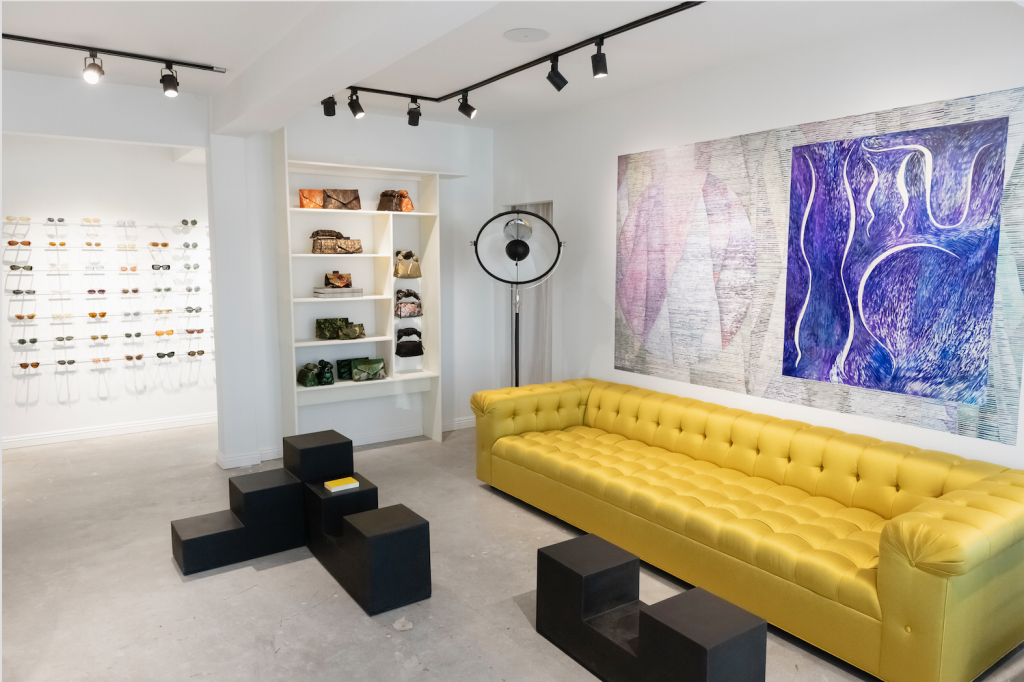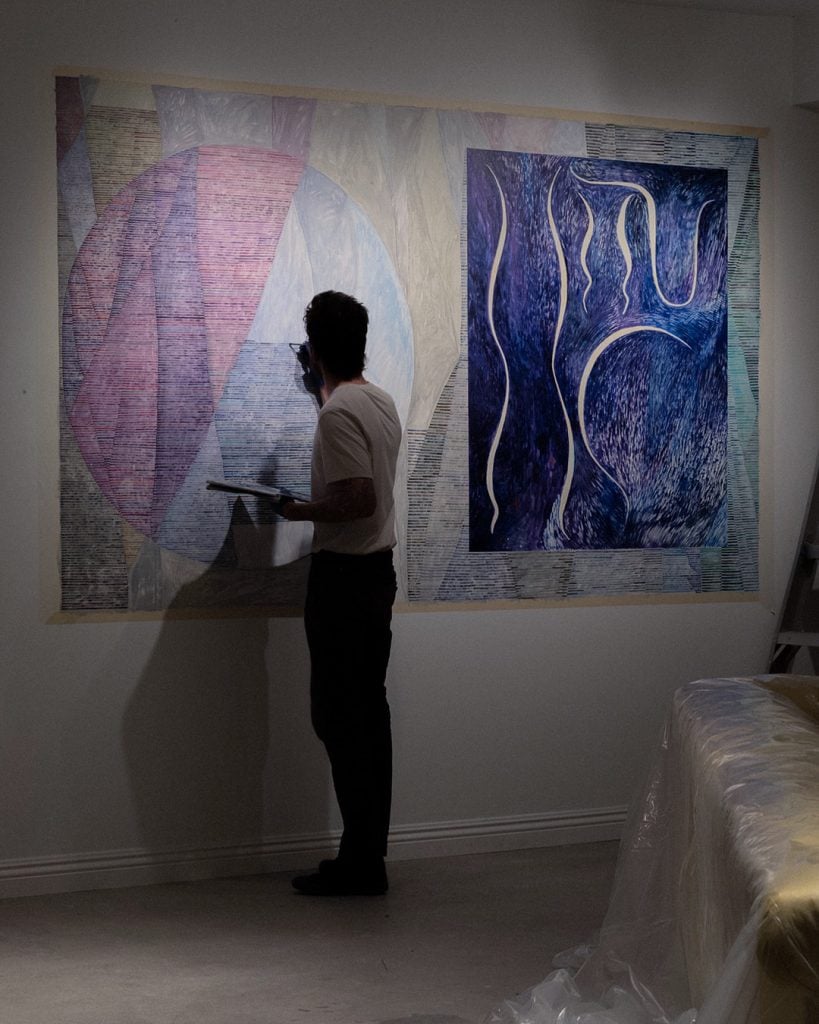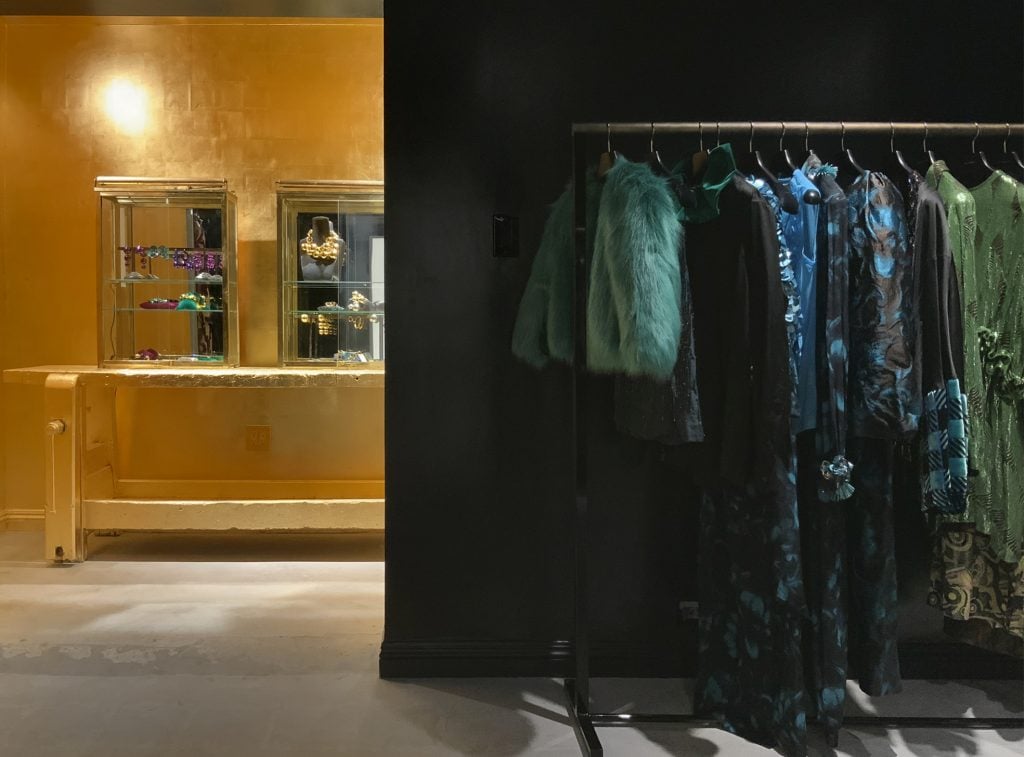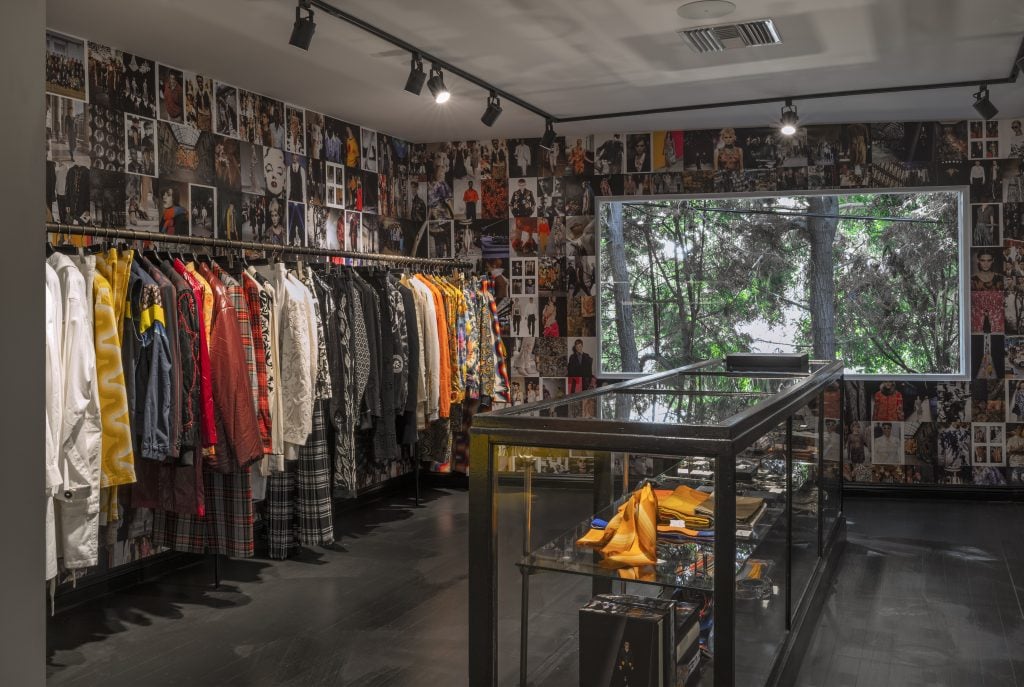People
‘Very Few People Work in Solitude’: Designer Dries Van Noten and Artist Adam Tullie on How Creatives Can Collaborate Across Disciplines
The pair recently worked together on an art project at the fashion designer’s new Los Angeles store.

The pair recently worked together on an art project at the fashion designer’s new Los Angeles store.

Noor Brara

In these turbulent times, creativity and empathy are more necessary than ever to bridge divides and find solutions. Artnet News’s Art and Empathy Project is an ongoing investigation into how the art world can help enhance emotional intelligence, drawing insights and inspiration from creatives, thought leaders, and great works of art.
Dries van Noten, one of Belgium’s most important fashion designers, began designing clothes in 1986. Recognized across the industry for his strict adherence to the integrity of his design process and company ethics, Van Noten has inspired countless young creatives in the art and fashion worlds alike to stake out on their own and remain steadfast in their pursuits.
Scored by his unorthodox, often fantastical use of color, pattern, and embroidery, Van Noten’s collections have also become synonymous with the art-influenced clothes of the day, made all the more evident by the settings in which they are sold: stores painstakingly planned and constructed to feature vibrant artworks.
Just as the lockdown was going into effect last spring, Van Noten opened a store on L.A.’s La Cienaga Boulevard, where, over FaceTime and email, he collaborated with young L.A.-based artist Adam Tullie, who created a sprawling work of art for the shop’s main room.
The two spoke with Artnet News about their collaboration, how the project came to be, and how the relationship between art and fashion has evolved over the years.

The new Dries Van Noten store in Los Angeles. Photo by Jim Mangan and courtesy Dries Van Noten.
How did you each come to have careers in fashion and art?
Dries: I was born into fashion. My grandfather was a tailor and had [clothing] stores, and my father and mother had their own stores in the ‘70s. I’d grown up around clothes and buying and traveling to Paris and Milan to see collections and shows. As a young adult, I felt I had two options: to rebel against my parents and not do what they did, or follow everything I’d learned up until that point.
For me it was the latter, but I didn’t want to do anything with the stores. I focused on fashion design, and in that, I was a little rebellious, I think, because my father was really hoping I’d take over the family business. And it was very strange at first, because in the late ‘70s and early ‘80s, Belgium was a country that people didn’t really expect a lot of fashion to come out of. It was mainly France and Italy—which itself was quite new, with Armani, Versace, and a little bit of Valentino. Then finally some Japanese designers came up, and some Spanish designers came up, and people started to become more open-minded that fashion could come from Belgium. We happened upon the right moment.
Adam: In my case, art is just something I’ve always gravitated towards. It’s always been second nature to me. I’ve never really given too much thought as to why I make art. It’s just more or less that I’m always drawn to visual information. As far as my background, I’m more self-taught than anything. There’s a multidisciplinary element to that as well—I ventured into music, and in my early 20s I was making clothes, too.
When did you two meet? How did you come to work together?
Dries: It’s a complicated story. During the first lockdown in March or April, the Opening Ceremony store was closing. It was always a space I’d really liked—they carried our clothes for so many years—and going into lockdown we knew the future, at least the near future, was only going to be about e-commerce. But then during lockdown, it became quite clear to me that real-life stores do in fact have a future, but they can’t only be spaces that sell clothes. You have to offer things that people can’t do on the internet.
We wanted to do things a different way. [In our new store,] we have different rooms where we can organize exhibitions, show our archives, host performances and workshops—different things that reflect culture beyond commerce. Ever since the store we opened in Paris in 2000, I’ve had artworks against the wall. I think we were the first to do that in a fashion store, in fact. I wanted to take the business strategy out of it and I wanted people to look at the juxtaposition of art and clothes as a sharing of ideas, beautiful concepts that speak to you for what they are.
Because we were in L.A., where street art is so important, I wanted to have more graffiti-type pieces. And I had the idea that maybe we’d have art directly on the wall—something you couldn’t commercialize or trade for money. It had to be part of the building, in the same way it would be if it were done on the facade.
So knowing that, and knowing people couldn’t travel, I contacted Jenny, the store director, and we started to look around. I got a shortlist of 25 artists, from which I picked a few I wanted to work with, and we contacted them. I dove into Adam’s work. It speaks to me and there’s a directness there I really love.
Adam: Jenny’s been a friend for a long time and she’s one of the best-dressed women in L.A. When she informed me that she was teaming up with Dries, I was elated. Ultimately, the way everything happened is exactly what Dries said—the work was submitted and we took it from there.
I couldn’t have been happier because I’ve been a fan of Dries’s work for many, many years. I think he’s a true master of color—on the level of Henri Matisse or Pierre Bonnard and Joseph Albers. He’s not a purist, but he pays homage and respect to traditional beauty.
In relation to graffiti, I think it’s a lot like fashion in a sense because you’re working within limited parameters. With fashion you’ve got form, silhouette, fabric, and with graffiti it’s about letters, immediacy, spontaneity, and all of those are limiting in a way I actually find very appealing. There’s an allure to graffiti and intimate mark-making and the speed at which it all goes down.

Tullie’s work hangs above a sofa at the Dries Van Noten L.A. store. Photo courtesy Dries Van Noten.
How much collaboration was there for the making of the actual artwork?
Adam: We were in contact, and from that, I was able to get a clear understanding of what in particular about my work resonated [with] Dries. I had Dries’s collections in mind as far as color and pattern, and we exchanged some information about direction and visual inspiration. Ultimately, we landed on the base composition that I painted on a wall. And in the moment and as I was working, of course, it evolved.
Dries: The thing that we can give the artist is the wall. In the system in which we work, it’s not that we tell them what to do—we give them a wall and a free hand.
With Adam, he gave us a selection of work and we picked what we liked most with what we perceived to be the clearest message for what we wanted, and then we said: “Here’s a wall. Make something now.” And that’s all it really was. That’s what I like about graffiti up the side of a building—you can’t really interfere with how it happened.
We like to give artists that sort of freedom, which for us is also a bit of a risk. In one case, we had someone work with plastic and acrylic and after it was done, the whole store smelled terribly—
Adam: That was another artist!
Dries: [laughs] Yes, that was not Adam. But it’s the coincidence factor that I’m attracted to. And in the case of Adam, it was a very positive surprise.
Adam: There was definitely a lot of freedom in the process, and I respected that so much because it’s such a pivotal room. It’s in the main room of the shop, and I thought that was definitely bold and risk-taking and lends itself to the overall essence of the work that Dries has produced over the last 20 or 30 years.

Tullie at work. Photo courtesy the artist.
What do you feel are the major points of difference and similarity in art and fashion?
Dries: I think there’s a love-hate relationship between art and fashion. I think there’s this idea in art that fashion wants to use art a little bit to magnify the visual impact of it and hide the commercial side. For me, art is of course an enormous source of inspiration, from the Flemish masters to contemporary art to Francis Bacon. I love a mix of high art and very low art also. I really like kitsch. For me, it’s a logical thing that, in a store, art is also present, but I don’t do it for the prestige factor.
These days, you see more and more stores have a Fontana against a wall or something like that—all very famous names. It’s not that for me. I don’t want to bring in that aspect of art, to scale up the status or anything like that. When I plan to have art in a store, it’s really about giving people the possibility of expressing themselves. Stores for me are about sensory experiences with multiple features—if you don’t like the clothes, fine, you might like the art or the books or the design and so on.
Adam: I think it’s interesting that as time progresses and we become more and more immersed in the digital world, it’s almost like technology has melded together all forms of visual information and there’s more and more crossover. A brilliant thinker, in my opinion, is Terrence McKenna and I think he said one time that the purpose of nature is to preserve novelty. That always stuck with me. As time moves forward, systems become increasingly complex and I think ultimately the way that these aesthetics come together now is with less and less division.

Inside the Dries Van Noten L.A. shop. Photo by Gareth Kantner and courtesy Dries Van Noten.
As you say, the internet has played a huge role in this heightened moment of cross pollination between creative fields. Are you ever skeptical of the model of the art-fashion collaboration? Do you feel like it’s more often than not something contrived and wholly commerce-driven?
Dries: I think you can do it in different ways—there are good and bad ways to do it. You have to choose how you want to do it. I think as Adam was saying, there are so many custom and collaborative relationships now that very few people are alone on their islands working in total solitude. I think if we do a fashion show—if we ever do fashion shows again—we’ll be able to work with artists to make the decor or the installation of the show and musicians and of course hair and makeup artists. We always need artists for these kinds of things. I think it’s always creativity and bringing over messages, so in that way, all art forms are merely trying to do the same thing, in a way.
Adam: I completely agree.
When looking at these two industries from the outside, a lot of people feel compelled to view fashion designers as slightly evil, very powerful figures made all the more powerful and evil by the backing of these behemoth companies, and most artists as humble individuals who are just trying to do their work behind closed doors. But it might be time to start thinking of artists, at least some artists, as single-entity businesses, and to remember that fashion houses are in fact driven by creative people, too.
Dries: Absolutely.
Adam: Of course. So much, in my opinion, also, comes down to taste. We put all this divisive labeling and categorization on each other when I think we’re essentially one in the same. Everyone is somebody that creates something and not just “a designer,” “an artist”, “a painter.” I like the idea of more fluidity and openness in that terrain.
If you had to trade professions for a day, what’s one task you’d be excited about doing?
Adam: I have a serious love for print. So I think that conceiving that aspect of the design process is especially exciting. And also taking into consideration commerce and the way in which a collection presented.
Dries: For me, I’d love to lose the pressure of the fashion side for a day. To make at least four or six collections a year, sometimes eight collections a year, is exhausting. I think to be able to work on something and say, “okay it’s not finished yet, let’s give it another day,” is a luxury I know artists have to work towards an exhibition, but they still have the freedom to say, “This isn’t good, I won’t show it.” We don’t have that. We have to show. We have to do the whole marketing thing. So that adds a layer of pressure.

Photo by Jim Mangan and courtesy Dries Van Noten.
I feel like when I’ve had these conversations in the past, it’s always the fashion person who craves a day of total freedom and the artist who wants 24 hours of impossible deadlines and intense structure.
Adam: [Laughs] There really is an accelerating factor to the strict deadlines in fashion that’s appealing! Obviously in the art world, we have them as well—shows, commissions, exhibitions—but the pressure alone in fashion is quite extreme.
Art has long been used to cultivate empathy and compassion, connecting people and reminding them of their shared humanity. How does empathy figure into your work and what’s one thing you’d like people to know about being a creative?
Dries: What I’m trying to do is make clothes that are a part of expressing who you are. I don’t want to make clothes to conjure a set personality. I want to give people tools to communicate on their own. I always say I hope I succeed in that. When people buy something of mine, I hope it becomes part of them.
Adam: It’s all about conveying an expression or representation of our time and culture. Whether it’s art, music, fashion, writing, or film—strong, compassionate work will effectively encapsulate contemporary relevance and ideas and hopefully transcend their media.